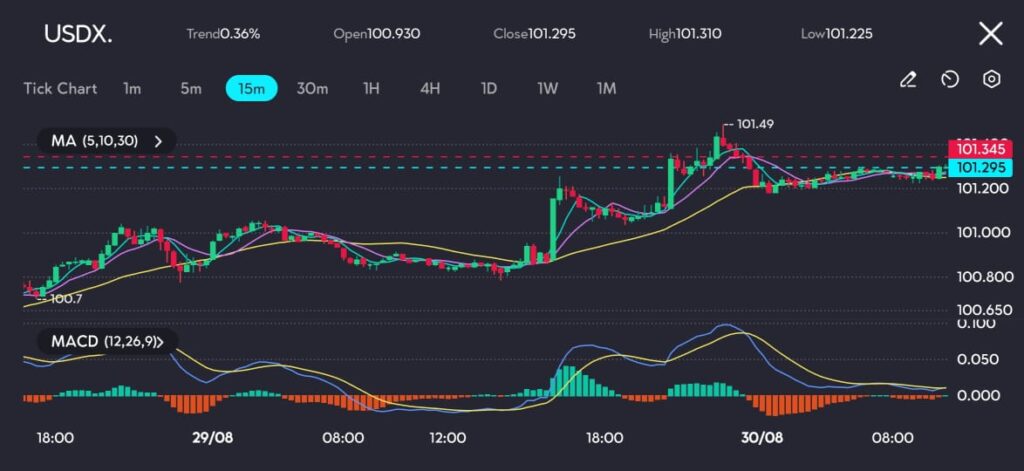Key points:
- The U.S. dollar is on track to end a five-week losing streak due to reduced expectations for aggressive Fed rate cuts.
- The euro and yen face pressure from lower inflation in Europe and rising U.S. Treasury yields.
The U.S. dollar is on track to snap a five-week losing streak, trading near a one-week high against major peers on Friday. This rebound comes as robust U.S. economic data has led traders to pare back their bets on aggressive Federal Reserve interest rate cuts.

See: Dollar index trading at 101.295 on the VT Markets app.
We go to the charts for guidance. The U.S. dollar is exhibiting renewed strength, as evidenced by the U.S. Dollar Index (DXY), which remains steady at 101.34 following a 0.36% rise on Thursday. This marks the index’s highest level since August 22, suggesting a resurgence in dollar demand amid market uncertainties.
If this trend continues, the dollar is poised to end the week with a solid 0.66% gain, its best weekly performance since early August.
The chart reflects a gradual upward trajectory in the dollar’s value, with the price holding above the key moving averages, indicating sustained buying interest. The MACD histogram is turning positive, suggesting that momentum is favoring further gains.
Market participants should be wary of the effect a strengthening dollar can have on the global economy. As the dollar strengthens, it exerts pressure on other currencies and commodities, potentially influencing broader market movements.
Revised GDP data reveals stronger-than-expected U.S. economic growth
The catalyst for this shift in market sentiment was the revised U.S. gross domestic product (GDP) data, which showed an annualised growth rate of 3.0% in the second quarter, up from the previously reported 2.8%. This revision exceeded expectations, highlighting the resilience of the U.S. consumer.
As a result, market participants have adjusted their expectations for the upcoming Federal Reserve meeting on September 18. The likelihood of a 50-basis point rate cut has decreased from 38% to 34%. This more cautious outlook on Fed easing has provided support for the dollar.
Euro under pressure as cooling inflation fuels ECB easing expectations
In contrast, the euro has struggled, lingering near a two-week low against the dollar. Cooling inflation in Germany and Spain has reinforced the case for European Central Bank (ECB) easing, putting downward pressure on the euro.
On Thursday, the euro dropped to $1.10555, its lowest level in two weeks, and remained flat at $1.1082 on Friday. With more consumer inflation data expected from France, Italy, and the broader eurozone, the euro’s outlook remains uncertain.
Yen struggles as U.S. Treasury yields overshadow stronger Tokyo inflation
The yen has also faced pressure, holding near the closely watched 145 per dollar level after weakening on Thursday. Despite Tokyo’s core consumer prices rising at a faster-than-expected 2.4% in August, surpassing the Bank of Japan’s 2% target, the yen has largely ignored this data.
Instead, the currency has been influenced by the rise in U.S. Treasury yields, which has supported the dollar against the yen. As of Friday, the dollar eased slightly to 144.78 yen after reaching 145.55 overnight, its highest level since August 23.
You might be interested: Japanese yen slips as the U.S. dollar rebounds
Sterling has remained steady, trading at $1.31655 after dipping to $1.3146 on Thursday. The release of the core personal consumption expenditures (PCE) price index, the Fed’s preferred inflation gauge, later in the day could further influence the market, particularly the dollar’s performance.
The cautious reduction in expectations for aggressive Fed rate cuts, coupled with a stronger-than-expected U.S. economy, suggests that the dollar may continue to find support in the near term.
However, ongoing inflation data from Europe and the U.S. could introduce new volatility, particularly for the euro and yen, as markets adjust to evolving economic conditions.
Start trading now — click here to create your live VT Markets account.









